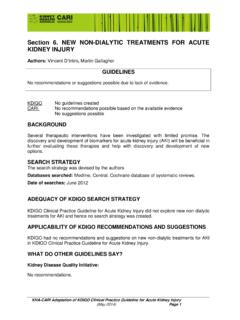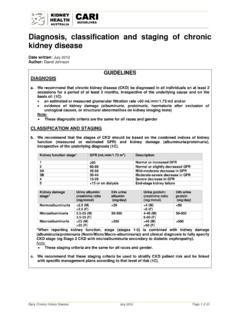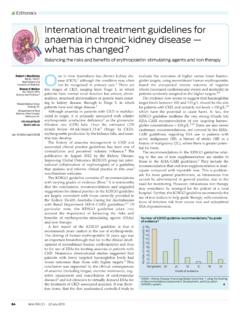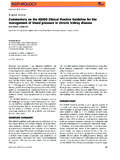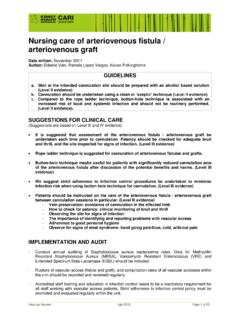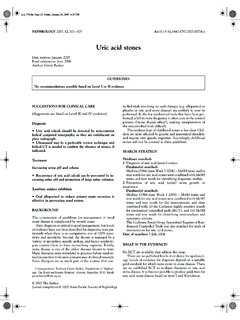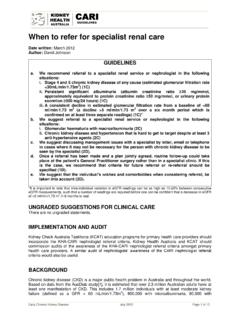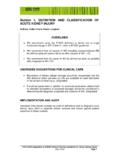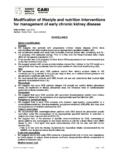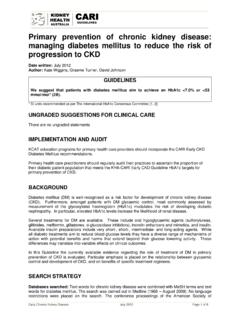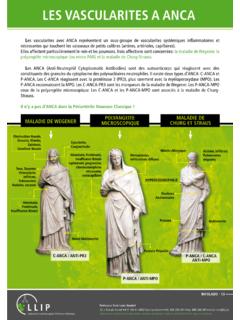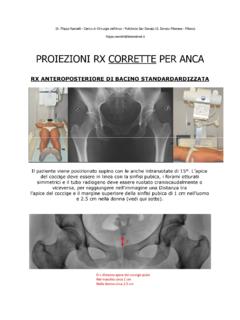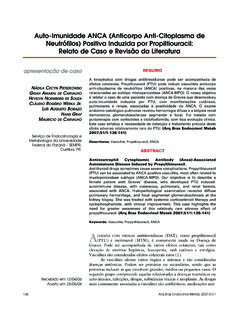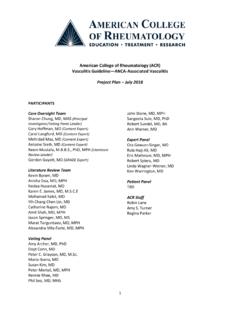Transcription of ANCA serology in the diagnosis and management of ANCA ...
1 NEPHROLOGY 2008; 13, S17 S23 anca serology in the diagnosis and management of ANCA-associated renal vasculitis Date written: June 2007. Final submission: October 2007. Author: Grant Luxton, Robyn Langham GUIDELINES. a. Serum anti-neutrophil cytoplasmic antibody (ANCA) measurement should not be used alone in the initial diagnosis of ANCA-associated vasculitis (AAV) but should be used in combination with the gold standard of tissue diagnosis . (Level 1 evidence). b. Measurement of ANCA by both ELISA and indirect immunofluorescence (IIF) in combination ensures optimal test sensitivity and specificity. (Level I evidence). c. The use of serial ANCA monitoring alone is insufficient to predict relapse or monitor disease activity. (Level I. evidence). SUGGESTIONS FOR CLINICAL CARE immune deposits (namely Wegener's granulomatosis [WG], microscopic polyangiitis [MPA] and Churg-Strauss syn- (Suggestions are based on Level III and IV evidence) drome [CSS]) are strongly associated with the presence of anti-neutrophil associated antibodies (ANCA).
2 The utility Test performance increases with increasing clinical fea- of diagnostic classifications of these diseases, commonly tures of disease. Test performance is poor as a screening referred to as the ANCA-associated vasculitides has been test in patients with few clinical features of AAV. contentious, largely due to the lack of incorporation of Rapid ELISA test may be helpful as an adjunct to histological, clinical and serological findings in the two urgent therapeutic decisions when formal histological main published classifications. In 1990, the American diagnosis is delayed, but should not supplant the need College of Rheumatology published classification criteria for for histological confirmation of disease and ANCA IIF vasculitis,4 which demonstrated high sensitivity and speci- testing. ficity for diagnosis of WG and CSS,5,6 but did not include Serial ANCA testing (ELISA and IIF) to monitor ANCA or MPA and was based on the presence of clinical disease activity may be useful in some situations as: symptoms and histopathological findings.
3 In 1994, the disappearance of ANCA is associated with disease Chapel Hill Consensus statement (CHCS)7 produced his- remission and a lower risk of relapse1,2 (Level IV tological definitions for vasculitides that were not intended evidence), as classification criteria. Anti-neutrophil cytoplasmic anti- reappearance or rising ANCA titre is of greater rel- bodies were not included in the definitions, although the evance in the setting of worsening clinical features, and authors recognised the importance of ANCA in small vessel the persistence of anti-proteinase 3 (ant-PR3) anti- vasculitis, as well as the use of surrogate clinical markers of bodies is associated with a higher risk of relapse3 (Level disease in the diagnosis . IV evidence). A number of studies have demonstrated marked dis- concordance of the two major diagnostic criteria, while BACKGROUND others have proposed modifications that attempt to better incorporate histology, surrogate markers and serology8 that The primary systemic vasculitides are a group of heteroge- have been evaluated for validity with additional modifica- neous clinical syndromes that are idiopathic in nature and tions recommended9.
4 More recently, a four-step algorithm classified by variable degrees of inflammation of the vessel has been developed10 as a basis for epidemiological studies wall. Classification of systemic vasculitis is complicated, and in an attempt to provide standardised criteria for future although the most widely accepted of these have usually clinical trials. This algorithm includes the use of histology, included consideration of the size of the vessel predomi- surrogate markers and serology , and uses exclusion criteria nantly involved and the histological appearance on biopsy. for other features that may mimic primary vasculitides. Renal involvement is particularly common in vasculiti- Incidence varies between regions11 and may also have des of the small vessels; those with paucity or absence of latitudinal variation. In Australia, AAV accounts for less 2008 The Authors Journal compilation 2008 Asian Pacific Society of Nephrology S18 The CARI Guidelines than 1% of end-stage kidney disease (ESKD).
5 With the fixation, all ANCAs stain in a cytoplasmic distribution. introduction of cyclophosphamide and prednisolone in However, following ethanol fixation, two distinct patterns the 1970s, the long-term prognosis for those with AAV are described, cytoplasmic (cANCA) and perinuclear improved dramatically. Due to the relatively high incidence (pANCA), depending on their relative charge. of disease, and the evolution of AAV into a chronic relaps- 1. The staining of ANCA reaction with proteinase (PR3), ing disease with a 5-year 80% survival, ANCA serology is a weaker cation or neutral protein, will result in a cytoplas- being increasingly used as a diagnostic marker of active mic fluorescent pattern called c-ANCA. disease. 2. When cytoplasmic granules redistribute resulting in a The purpose of this guideline is to review the available pANCA pattern, a number of antigens have been identified, clinical evidence relating to the usefulness of serial ANCA of which myeloperoxidase (MPO) is the only one of clinical testing to diagnose disease and to predict clinical relapse.
6 Importance. ANCA antigens (PR3 and MPO) are measured in serum using ELISA, freely available in kit form. A. ANCA serology in the diagnosis of The international consensus statement on reporting of ANCA-associated vasculitis ANCA recognised the association of other diseases with ANCAs that have atypical staining patterns on IIF or anti- It was some time ago that the renal lesion of rapidly pro- gens other than the two described (PR3 and MPO) and gressive glomerulonephritis in the absence of identifiable recommended both IIF and ELISA testing when seeking to immune deposits was recognised as a distinct identify ANCA, but also stressed the importance of histo- Although acknowledged to have a variable clinical presen- logical confirmation as the gold The statement tation of systemic necrotising vasculitis or in some cases, a proposes screening ANCA by IIF, followed by confirmation renal limited lesion, it was some time before the Chapel Hill by both protease-3 ELISA and myeloperoxidase-ELISA.
7 Consensus formally defined the clinical subgroups that com- Furthermore, they recommend that negative results by IIF. prise systemic vasculitis. In the case of the pauci-immune should also be tested by ELISA, as 5% of samples are only renal lesion, three sub-groups were described, based on positive by ELISA. clinical and histological variants:7. 1. Wegener's granulomatosis was defined as a granulo- matous inflammation affecting the respiratory tract and necrotising vasculitis affecting small-sized to medium-sized ANCA test performance vessels, where necrotising glomerulonephritis is common. Although it was noted in the Chapel Hill statement that 2. Churg-Strauss syndrome was defined as an eosinophil- ANCAs (IIF/ELISA) are useful in the definition of small rich granulomatous inflammation in the respiratory tract, vessel vasculitis with the renal lesion being that of pauci- with necrotising vasculitis affecting small-sized to medium- immune focal necrotising glomerulonephritis, the presence sized vessels and associated with asthma and eosinophilia.
8 Of ANCAs was not considered in the diagnostic schema. It 3. Microscopic polyangiitis was also described as a necrotis- has since been demonstrated that the use of the Chapel Hill ing vasculitis, with few or no immune deposits, affecting criteria in isolation has poor predictive value,8 and studies small vessels. Necrotising arteritis involving small-sized and have since focused on the diagnostic utility of the various medium-sized arteries might be present and necrotising ANCA markers in comparison with histological diagnosis . glomerulonephritis is very common. Pulmonary capillaritis Earlier studies14,17 21 demonstrated limited sensitivity of frequently arises. ANCA by IIF alone, often examining only one disease The renal lesion of pauci-immune vasculitides is recognised group. An early study incorporating ELISA assays by Sinico in the early stages by fibrinoid necrosis of capillary loops, et examined a renal specific population of rapidly pro- with progression to diffuse proliferative, pauci-immune gressive renal failure and/or disease with systemic vasculitis.
9 Glomerulonephritis with basement membrane rupture and Prospective analysis of 1535 serum ANCAs in 920 consecu- cells in Bowman's space and an associated interstitial reac- tive patients, using histology as comparator, confirmed a tion. As with other progressive renal pathologies, the end- high sensitivity and specificity for ANCA by IIF, with stage is that of sclerosed glomeruli. higher sensitivity when used in conjunction with ELISA. With the development of standardised techniques for IIF. Anti-neutrophil cytoplasmic antibodies and ELISA, collaborative groups have determined the diag- nostic value of standardised ANCA assays. The largest of It was in 1982 that ANCAs were first described in a cohort these is from the EC/BR project for ANCA assay standardi- of patients with segmental necrotising glomerulonephritis. sation,23 a multi-centre analysis of ANCA assays compared Davies et al. described cytoplasmic staining of neutrophils with histology, which comprised 169 prospective and 189.
10 When studying nuclear antibodies using IIF in 8 patients, 7 retrospective biopsies and sera, along with 184 disease con- of whom had positive Ross River virus It was trols and 740 healthy controls. When using ANCA IIF and shortly after, that the association of ANCAs with WG14 and ELISA in combination, the tests were of high specificity MPA15 was described. (99%), with sensitivity of 73% and 67% for WG and MPA, ANCAs are antibodies directed against primary granules respectively. The conclusion is that the value of the IIF. of neutrophil and monocyte lysosomes. Without ethanol test for ANCA detection can be greatly increased by the Renal Vasculitis S19. addition of ELISA. The authors did note, however, that in is thought that timely identification may allow early detec- a significant number of patients with idiopathic small vessel tion of disease relapse, which can subsequently be confirmed vasculitis, the ANCA results were negative. Similarly, on clinical findings or further investigation and allow Harris et al.
